Diffuse Reflectance Spectroscopy for Mapping Soil Carbon Stock in the Gilbués Desertification Region at Brazilian Cerrado
Abstract
1. Introduction
2. Materials and Methods
2.1. Study Area
2.2. Soil Sampling and Laboratory Analysis
2.3. Spectral Measurements
2.4. Statistics and Pedometrics Modeling
2.5. Geostatistical Modeling
3. Results
3.1. Descriptive Analysis
3.2. Spectral Characteristics and Prediction Models
3.3. Spatial Variability of Chemical Properties and Granulometric Fractions
4. Discussion
4.1. Pedogenesis
4.2. Pedometrics
4.3. Spatial Variability of the Soil Properties
5. Conclusions
Author Contributions
Funding
Data Availability Statement
Acknowledgments
Conflicts of Interest
References
- Santos, D.P.; Marchão, R.L.; Barbosa, R.S.; Junior JPd, S.; Silva, E.M.; Nóbrega, J.C.A.; Niva, C.C.; Santos, G.G. Soil macrofauna associated with cover crops in an Oxisol from the southwest of Piauí state, Brazil. Arq. Inst. Biol. 2020, 87, 1–9. [Google Scholar] [CrossRef]
- Simplício, A.A.F.; Costa, C.A.G.; Navarro-Hevia, J.; Araújo, J.C. Erosion at hillslope and micro-basin scales in the Gilbués desertification region, Northeastern Brazil. Land Degrad. Dev. 2021, 32, 1487–1499. [Google Scholar] [CrossRef]
- de O-Lopes, L.S.; Soares, R.C. Desertification susceptibility of Gilbués (Piauí State) and Cabrobó (Pernambuco State) drylands, in Northeastern Brazil. Rev. Geogr. Am. Cent. 2016, 1, 307–323. [Google Scholar] [CrossRef][Green Version]
- Costa, A.R.S.; Ferreira, G.L.; Souza, E.B.; Rolim Neto, F.C. Desertification in semi-arid northeast of Brazil. Rev. Geama 2016, 2, 427–445. [Google Scholar]
- França, C.J.L.; Piuzana, D.; Ross, L.S.J. Potential and emerging environmental fragility in desertification nucleus in the brazilian semi-arid (Gilbués, Piauí). Espacios 2017, 575, 1056–1065. [Google Scholar]
- Valladares, G.S.; Júnior, A.F.; da Aquino, C.M. Soils characterization in the desertification nucleus of Gilbués, Piauí, Brazil, and their relationship with degradation processes. Physis Terrae-Rev. Ibero-Afro-Am. Geogr. Física Ambiente 2020, 2, 115–135. [Google Scholar] [CrossRef]
- Lal, R. Climate Change and Soil Degradation Mitigation by Sustainable Management of Soils and Other Natural Resources. Agric. Res. 2012, 1, 199–212. [Google Scholar] [CrossRef]
- Intergovernmental Panel on Climate Change (IPCC). Aquecimento Global de 1.5 °C: Sumário para Formuladores de Políticas; IPCC: Geneva, Switzerland, 2023; p. 28. Available online: https://www.ipcc.ch/site/assets/uploads/2019/07/SPM-Portuguese-version.pdf (accessed on 10 January 2023).
- Tan, Z.; Leung, L.R.; Li, H.Y.; Tesfa, T.; Zhu, Q.; Huang, M. A substantial role of soil erosion in the land carbon sink and its future changes. Glob. Chang. Biol. 2020, 26, 2642–2655. [Google Scholar] [CrossRef] [PubMed]
- Sorenson, P.T.; Quideau, S.A.; Rivard, B. High resolution measurement of soil organic carbon and total nitrogen with laboratory imaging spectroscopy. Geoderma 2018, 315, 170–177. [Google Scholar] [CrossRef]
- Friedlingstein, P.; O’Sullivan, M.; Jones, M.W.; Andrew, R.M.; Gregor, L.; Hauck, J.; Le Quéré, C.; Luijkx, I.T.; Olsen, A.; Peters, G.P.; et al. Data used with permission of the Global Carbon Project under the Creative Commons Attribution 4.0 International license. Earth Syst. Sci. Data 2020, 12, 3269–3340. [Google Scholar] [CrossRef]
- Angelopoulou, T.; Tziolas, N.; Balafoutis, A.; Zalidis, G.; Bochtis, D. Remote sensing techniques for soil organic carbon estimation: A review. Remote Sens. 2019, 11, 676. [Google Scholar] [CrossRef]
- Bünemann, E.K.; Bongiorno, G.; Bai, Z.; Creamer, R.E.; de Deyn, G.; de Goede, R.; Fleskens, L.; Geissen, V.; Kuyper, T.W.; Mäder, P.; et al. Soil quality—A critical review. Soil Biol. Biochem. 2018, 120, 105–125. [Google Scholar] [CrossRef]
- Milne, E.; Banwart, S.A.; Noellemeyer, E.; Abson, D.J.; Ballabio, C.; Bampa, F.; Bationo, A.; Batjes, N.H.; Bernoux, M.; Bhattacharyya, T.; et al. Soil carbon, multiple benefits. Environ. Dev. 2015, 13, 33–38. [Google Scholar] [CrossRef]
- Villarino, S.H.; Studdert, G.A.; Baldassini, P.; Cendoya, M.G.; Ciuffoli, L.; Mastrángelo, M.; Piñeiro, G. Deforestation impacts on soil organic carbon stocks in the Semiarid Chaco Region, Argentina. Sci. Total Environ. 2017, 575, 1056–1065. [Google Scholar] [CrossRef] [PubMed]
- Bogunovic, I.; Pereira, P.; Brevik, E.C. Spatial distribution of soil chemical properties in an organic farm in Croatia. Sci. Total Environ. 2017, 584–585, 535–545. [Google Scholar] [CrossRef] [PubMed]
- Nabiollahi, K.; Shahlaee, S.; Zahedi, S. Land use and soil organic carbon stocks—Change detection over time using digital soil assessment: A case study from Kamyaran Region, Iran (1988–2018). Agronomy 2021, 11, 597. [Google Scholar] [CrossRef]
- Nijbroek, R.; Piikki, K.; Söderström, M.; Kempen, B.; Turner, K.; Hengari, S.; Mutua, J. Soil organic carbon baselines for land degradation neutrality: Map accuracy and cost tradeoffs with respect to complexity in Otjozondjupa, Namibia. Sustainability 2018, 10, 1610. [Google Scholar] [CrossRef]
- McDowell, M.L.; Bruland, G.L.; Deenik, J.L.; Grunwald, S.; Knox, N.M. Soil total carbon analysis in Hawaiian soils with visible, near-infrared and mid-infrared diffuse reflectance spectroscopy. Geoderma 2012, 189–190, 312–320. [Google Scholar] [CrossRef]
- Demattê, J.A.M.; Dotto, A.C.; Paiva, A.F.; Sato, M.V.; Dalmolin, R.S.; de Araújo, M.D.S.B.; da Silva, E.B.; Nanni, M.R.; ten Caten, A.; Noronha, N.C.; et al. The Brazilian Soil Spectral Library (BSSL): A general view, application and challenges. Geoderma 2019, 354, 113793. [Google Scholar] [CrossRef]
- Nawar, S.; Mouazen, A.M. On-line vis-NIR spectroscopy prediction of soil organic carbon using machine learning. Soil Tillage Res. 2019, 190, 120–127. [Google Scholar] [CrossRef]
- Moura-Bueno, J.M.; Dalmolin, R.S.D.; Horst-Heinen, T.Z.; Caten, A.T.; Vasques, G.M.; Dotto, A.C.; Grunwald, S. When does stratification of a subtropical soil spectral library improve predictions of soil organic carbon content? Sci. Total Environ. 2020, 737, 139895. [Google Scholar] [CrossRef] [PubMed]
- Viscarra Rossel, R.A.; Walvoort, D.J.J.; McBratney, A.B.; Janik, L.J.; Skjemstad, J.O. Visible, near infrared, mid infrared or combined diffuse reflectance spectroscopy for simultaneous assessment of various soil properties. Geoderma 2006, 131, 59–75. [Google Scholar] [CrossRef]
- Carvalho, J.K.; Moura-Bueno, J.M.; Ramon, R.; Almeida, T.F.; Naibo, G.; Martins, A.P.; Santos, S.L.; Gianello, C.; Tiecher, T. Combining different pre-processing and multivariate methods for prediction of soil organic matter by near infrared spectroscopy (NIRS) in Southern Brazil. Geoderma Reg. 2022, 29, e00530. [Google Scholar] [CrossRef]
- Conforti, M.; Buttafuoco, G. Insights into the Effects of Study Area Size and Soil Sampling Density in the Prediction of Soil Organic Carbon by Vis-NIR Diffuse Reflectance Spectroscopy in Two Forest Areas. Land 2023, 12, 44. [Google Scholar] [CrossRef]
- Farifteh, J.; van der Meer, F.; Atzberger, C.; Carranza, E.J.M. Quantitative Analysis of Salt-Affected Soil Reflectance Spectra: A Comparison of Two Adaptive Methods (PLSR and ANN). Remote Sens. Environ. 2007, 110, 59–78. [Google Scholar] [CrossRef]
- Silva, I.A.d.S. Environmental degradation in Gilbués-pi: Conceptual bases, geoenvironmental restrictions and impacts in the landscape. Rev. Equador 2013, 1, 14–29. [Google Scholar] [CrossRef]
- Macambira, D.M.; Gomes, J.M.A. Desertification in Gilbués—Piauí under the perspective of environmental history. Hist. Quest. Debates 2021, 69, 155–186. [Google Scholar] [CrossRef]
- de Silva, I.A.S. Clima e Arenização em Gilbués-Piauí: Dinâmica das Precipitações e a Vulnerabilidade da Paisagem aos Eventos Pluviais Intensos. Master’s Thesis, (Mestrado em Geografia)–Instituto de Estudos Socioambientais, Universidade Federal de Goiás, Goiânia, Brasil, 2014. [Google Scholar]
- Sales, M.C.L. Environmental degradation in Gilbués, Piauí. Mercat.-Rev. Geog. UFC 2003, 2, 115–134. [Google Scholar]
- de Aguiar, R.B.; Gomes, J.R.d.C. Project Registration of Groundwater Supply Sources State of Piauí Diagnosis of the Municipality of Monte Alegre do Piauí; CPRM: Brisbane, Australia, 2004. [Google Scholar]
- IUSS Working Group WRB. World Reference Base for Soil Resources. International Soil Classification System for Naming Soils and Creating Legends for Soil Maps, 4th ed.; International Union of Soil Sciences (IUSS): Vienna, Austria, 2022. [Google Scholar]
- dos Santos, H.G.; Jacomine, P.K.T.; dos Anjos, L.H.C.; de Oliveira, V.A.; Lumbreras, J.F.; Coelho, M.R.; Almeida, J.A.; Filho, J.C.d.A.; de Oliveira, J.B.; Cunha, T.J.F. Brazilian System of Soil Classification, 5th ed.; Embrapa: Brasília, Brazil, 2018; p. 355. [Google Scholar]
- Soil Survey Staff. Soil Taxonomy: A Basic System of Soil Classification for Making and Interpreting Soil Surveys, 2nd ed.; U.S. Department of Agriculture Handbook 436; Natural Resources Conservation Service: Washington, DC, USA, 1999; p. 869. [Google Scholar]
- RADAM Brasil. Projeto RADAM Brasil. DNPM/Projeto; Departamento Nacional de Produção Mineral: Rio de Janeiro, Brazil, 1973; p. 507. [Google Scholar]
- Câmara, E.R.G.; dos Santos, J.C.B.; Filho, J.C.d.A.; Schulze, S.M.B.; Corrêa, M.M.; Ferreira, T.O.; de Sousa, J.E.S.; Júnior, V.S.d.S. Parent rock–pedogenesis relationship: How the weathering of metamorphic rocks influences the genesis of Planosols and Luvisols under a semiarid climate in NE Brazil. Geoderma 2021, 385, 114878. [Google Scholar] [CrossRef]
- Crepani, E.; Medeiros, J.S.; Palmeira, A.F.; Silva, E.F. Geographic Database of the Municipalities of Gilbués and Monte Alegre do Piauí (PI) (Municipalities Belonging to the Gilbués Desertification Nucleous); INPE: São José dos Campos, Brazil, 2008. [Google Scholar]
- Neves, L.V.M.W.; Sousa, J.E.S.; Santos, J.C.B.; Araújo Filho, J.C.; Corrêa, M.M.; Sousa, M.G.; Fracetto, F.J.C.; Fracetto, G.G.M.; Araujo, J.K.S.; Freire, G.A.P.; et al. Weathering of gneiss saprolites and formation of Planosols under semiarid climate (NE Brazil). J. S. Am. Earth Sci. 2023, 123, 104206. [Google Scholar] [CrossRef]
- Teixeira, P.C.; Donagemma, G.K.; Fontana, A.; Teixeira, W.G. Soil Analysis Methods Manual, 3rd ed.; Embrapa: Brasilia, Brazil, 2017; p. 574. [Google Scholar]
- Silva, A.C.; Torrado, P.V.; Abreu Junior, J.S. Methods for quantifying soil organic matter. Rev. Unifenas Alfenas 1999, 5, 21–26. [Google Scholar]
- Grossman, R.B.; Reinsch, T.G. Bulk density and linear extensibility. In Methods of Soil Analysis, Part 4: Physical Methods; Soil Science Society of America: Madison, WI, USA, 2002; pp. 201–228. [Google Scholar]
- Solomon, D.; Fritzsche, F.; Lehmann, J.; Tekalign, M.; Zech, W. Soil Organic Matter Dynamics in the Subhumid Agroecosystems of the Ethiopian Highlands. Soil Sci. Soc. Am. J. 2002, 66, 969–978. [Google Scholar] [CrossRef]
- Terra, F.S.; Demattê, J.A.M.; Viscarra Rossel, R.A. Spectral libraries for quantitative analyses of tropical Brazilian soils: Comparing vis-NIR and mid-IR reflectance data. Geoderma 2015, 255–256, 81–93. [Google Scholar] [CrossRef]
- Terra, F.S.; Demattê, J.A.M.; Viscarra Rossel, R.A. Proximal spectral sensing in pedological assessments: Vis–NIR spectra for soil classification based on weathering and pedogenesis. Geoderma 2018, 318, 123–136. [Google Scholar] [CrossRef]
- Viscarra Rossel, R.A. ParLeS: Software for chemometric analysis of spectroscopic data. Chemom. Intell. Lab. Syst. 2008, 90, 72–83. [Google Scholar] [CrossRef]
- Geladi, P.; MacDougall, D.; Martens, H. Linearization and scatter-correction for near-infrared reflectance spectra of meat. Appl. Spectrosc. 1985, 39, 491–500. [Google Scholar] [CrossRef]
- Barnes, R.J.; Dhanoa, M.S.; Lister, S.J. Standard normal variate transformation and de-trending of near-infrared diffuse reflectance spectra. Appl. Spectrosc. 1989, 43, 772–777. [Google Scholar] [CrossRef]
- Savitzky, A.; Golay, M.J.E. Smoothing and differentiation of data by simplified least squares procedures. Anal. Chem. 1964, 36, 1627–1639. [Google Scholar] [CrossRef]
- Minitab, L.L.C. Minitab Statistical Software, Release 21.1.1.; Minitab, LLC: State College, PA, USA, 2022. [Google Scholar]
- Chang, C.W.; Laird, D.A.; Mausbach, M.J.; Hurburgh, C.R. Near-Infrared Reflectance Spectroscopy-Principal Components Regression Analyses of Soil Properties. Soil Sci. Soc. Am. J. 2001, 65, 480–490. [Google Scholar] [CrossRef]
- Viera, S.R. Geostatistics in soil spatial variability studies. Tópicos Ciência Solo 2000, 1, 1–54. [Google Scholar]
- Cambardella, C.A.; Moorman, T.B.; Novak, J.M.; Parkin, T.B.; Karlen, D.L.; Turco, R.F.; Konopka, A.E. Field-Scale Variability of Soil Properties in Central Iowa Soils. Soil Sci. Soc. Am. J. 1994, 58, 1501–1511. [Google Scholar] [CrossRef]
- Oliveira, D.L.B.; Pereira, L.H.d.S.; Schneider, M.P.; Silva, Y.J.A.B.; Nascimento, C.W.A.; van Straaten, P.; Veras, G. Bio-inspired algorithm for variable selection in i-PLSR to determine physical properties, thorium and rare earth elements in soils from Brazilian semiarid region. Microchem. J. 2021, 160, 105640. [Google Scholar] [CrossRef]
- Silva, S.H.G.; Weindorf, D.C.; Pinto, L.C.; Faria, W.M.; Acerbi Junior, F.W.; Gomide, L.R.; Mello, J.M.; Pádua Junior, A.L.; Souza, I.A.; Teixeira, A.F.S.; et al. Soil texture prediction in tropical soils: A portable X-ray fluorescence spectrometry approach. Geoderma 2020, 362, 114136. [Google Scholar] [CrossRef]
- Gomes, L.C.; Faria, R.M.; de Souza, E.; Veloso, G.V.; Schaefer, C.E.G.; Fernandes Filho, E.I. Modelling and mapping soil organic carbon stocks in Brazil. Geoderma 2019, 340, 337–350. [Google Scholar] [CrossRef]
- Harrison-Kirk, T.; Beare, M.H.; Meenken, E.D.; Condron, L.M. Soil organic matter and texture affect responses to dry/wet cycles: Effects on carbon dioxide and nitrous oxide emissions. Soil Biol. Biochem. 2013, 57, 43–55. [Google Scholar] [CrossRef]
- Lenka, S.; Singh, A.K.; Lenka, N.K. Soil water and nitrogen interaction effect on residual soil nitrate and crop nitrogen recovery under maize–wheat cropping system in the semi-arid region of northern India. Agric. Ecosyst. Environ. 2013, 179, 108–115. [Google Scholar] [CrossRef]
- Jobbágy, E.G.; Jackson, R.B. The vertical distribution of soil organic carbon and its relation to climate and vegetation. Ecol. Appl. 2000, 10, 423–436. [Google Scholar] [CrossRef]
- Tang, X.; Xia, M.; Pérez-Cruzado, C.; Guan, F.; Fan, S. Spatial distribution of soil organic carbon stock in Moso bamboo forests in subtropical China. Sci. Rep. 2017, 7, srep42640. [Google Scholar] [CrossRef]
- Li, Y.; Liu, Z.; Li, S.; Li, X. Multi-scenario simulation analysis of land use and carbon storage changes in Changchun city based on FLUS and InVEST model. Land 2022, 11, 647. [Google Scholar] [CrossRef]
- van Raij, B.; Quaggio, J.A. Determination of phosphorus, calcium, magnesium and potassium extracted with ion exchange resin. In Book Chemical Analysis to Assess the Fertility of Tropical Soils; van Raij, B., de Andrade, J.C., Cantarella, H., Quaggio, J.A., Eds.; Instituto Agronômico: Campinas, Brazil, 2001; pp. 189–199. [Google Scholar]
- Mendes, W.D.S.; Boechat, C.L.; Gualberto, A.V.S.; Barbosa, R.S.; Silva, Y.J.A.B.D.; Saraiva, P.C.; Duarte, L.D.S.L. Soil spectral library of Piauí state using machine learning for laboratory analysis in Northeastern Brazil. Rev. Bras. Cienc. Solo 2021, 45, e0200115. [Google Scholar] [CrossRef]
- Souza, Y.A.F.; Leite, M.G.P.; Fujaco, A.M.G. A hydroelectric dam borrow pit rehabilitation. Two decades after the project, what went wrong? J. Environ. Manag. 2021, 293, 112850. [Google Scholar] [CrossRef] [PubMed]
- Blanco-Canqui, H.; Shaver, T.M.; Lindquist, J.L. Soil degradation as a reason for yield plateau in no-till corn and soybean. Soil Sci. Soc. A J. 2015, 79, 723–730. [Google Scholar]
- Stevens, A.; Udelhoven, T.; Denis, A. Exploring the spectral properties of soils from the UV to the thermal infrared: A spectral library of 400 soil samples. Remote Sens. Environ. 2018, 216, 423–430. [Google Scholar]
- Chabrillat, S.; Ben-Dor, E.; Cierniewski, J.; Gomez, C.; Schmid, T.; van Wesemael, B. Imaging spectroscopy for soil mapping and monitoring. Surv. Geophys. 2019, 40, 361–399. [Google Scholar] [CrossRef]
- Demattê, J.A.M.; Horák-Terra, I.; Beirigo, R.M.; Terra, F.d.S.; Marques, K.P.P.; Fongaro, C.T.; Vidal-Torrado, P. Genesis and properties of wetland soils by VIS-NIRSWIR as a technique for environmental monitoring. J. Environ. Manag. 2017, 197, 50–62. [Google Scholar] [CrossRef]
- Dotto, A.C.; Dalmolin, R.S.D.; Caten, A.T.; Grunwald, S. A systematic study on the application of scatter-corrective and spectral-derivative preprocessing for multivariate prediction of soil organic carbon by Vis-NIR spectra. Geoderma 2008, 314, 262–274. [Google Scholar] [CrossRef]
- Resende, F.V.; Souza, L.S.D.; Oliveira, P.S.R.D.; Gualberto, R. Efficiency of mulching on soil moisture and temperature, weed control and yield of carrot in summer season. Cienc. Agrotec. 2005, 29, 100–105. [Google Scholar] [CrossRef]
- Demattê, J.A.M.; Fongaro, C.T.; Rizzo, R.; Safanelli, J.L. Geospatial Soil Sensing System (GEOS3): A powerful data mining procedure to retrieve soil spectral reflectance from satellite images. Remote Sens. Environ. 2018, 212, 161–175. [Google Scholar] [CrossRef]
- Benedet, L.; Faria, W.M.; Silva, S.H.G.; Mancini, M.; Demattê, J.A.M.; Guilherme, L.R.G.; Curi, N. Soil texture prediction using portable X-ray fluorescence spectrometry and visible near-infrared diffuse reflectance spectroscopy. Geoderma 2020, 376, 114553. [Google Scholar] [CrossRef]
- Viscarra Rossel, R.A.; Behrens, T.; Ben-Dor, E.; Brown, D.J.; Demattê, J.A.M.; Shepherd, K.D.; Shi, Z.; Stenberg, B.; Stevens, A.; Adamchuk, V.; et al. A global spectral library to characterize the world’s soil. Earth-Sci. Rev. 2016, 155, 198–230. [Google Scholar] [CrossRef]
- Stenberg, B.; Rossel, R.A.V.; Mouazen, A.M.; Wetterlind, J. Visible and near infrared spectroscopy in soil science. Adv. Agron. 2010, 107, 163–215. [Google Scholar] [CrossRef]
- Nocita, M.; Stevens, A.; van Wesemael, B.; Aitkenhead, N.; Bachmann, M.; Barthès, B.; Ben Dor, E.; Brown, D.J.; Clairotte, M.; Csorba, A.; et al. Soil spectroscopy: An alternative to wet chemistry for soil monitoring. Adv. Agron. 2015, 132, 139–159. [Google Scholar] [CrossRef]
- Sousa, J.E.S.; Andrade, G.R.P.; de Araújo Filho, J.C.; dos Santos, J.C.B.; Corrêa, M.M.; Ferreira, T.O.; de Souza Júnior, V.S. Weathering and mineral alteration of metamorphic rocks and genesis of Planosols along a rainfall gradient in Borborema Province, Northeast Brazil. Geoderma Reg. 2023, 33, 00642. [Google Scholar] [CrossRef]
- Stevens, A.; Nocita, M.; Tóth, G.; Montanarella, L.; van Wesemael, B. Prediction of Soil Organic Carbon at the European Scale by Visible and Near InfraRed Reflectance Spectroscopy. PLoS ONE 2013, 8, e66409. [Google Scholar] [CrossRef]
- Wang, L.; Wang, R. Determination of soil pH from Vis-NIR spectroscopy by extreme learning machine and variable selection: A case study in lime concretion black soil. Spectrochim. Acta Part A Mol. Biomol. Spectrosc. 2022, 283, 121707. [Google Scholar] [CrossRef] [PubMed]
- Wan, M.; Qu, M.; Hu, W.; Li, W.; Zhang, C.; Cheng, H.; Huang, B. Estimation of soil pH using PXRF spectrometry and Vis-NIR spectroscopy for rapid environmental risk assessment of soil heavy metals. Proc. Saf. Environ. Prot. 2013, 132, 73–181. [Google Scholar] [CrossRef]
- Clark, R.N.; King, T.V.V.; Klejwa, M.; Swayze, G.; Vergo, N. High spectral resolution reflectance spectroscopy of minerals. J. Geophys. Res. 1990, 95, 12653–12680. [Google Scholar] [CrossRef]
- Viscarra Rossel, R.A.; Lobsey, C.R.; Sharman, C.; Flick, P.; McLachlan, G. Novel proximal sensing for monitoring soil organic C stocks and condition. Environ. Sci. Technol. 2017, 51, 5630–5641. [Google Scholar] [CrossRef]
- Iorio, E.D.; Circelli, L.; Lorenzetti, R.; Costantini, E.A.; Egendorf, S.P.; Colombo, C. Estimation of andic properties from Vis-NIR diffuse reflectance spectroscopy for volcanic soil classification. Catena 2019, 182, 104109. [Google Scholar] [CrossRef]
- Clark, D.H.; Lamb, R.C. Near infrared reflectance spectroscopy: A survey of wavelength selection to determine dry matter digestibility. J. Dairy Sci. 1991, 74, 2200–2205. [Google Scholar] [CrossRef]
- Demattê, J.A.M.; Terra, F.S. Spectral pedology: A new perspective on evaluation of soils along pedogenetic alterations. Geoderma 2014, 217–218, 190–200. [Google Scholar] [CrossRef]
- Gozukara, G.; Akça, E.; Dengiz, O.; Kapur, S.; Adak, A. Soil particle size prediction using Vis-NIR and pXRF spectra in a semiarid agricultural ecosystem in Central Anatolia of Türkiye. Catena 2022, 217, 106514. [Google Scholar] [CrossRef]
- Hong, H.; Cheng, F.; Yin, K.; Churchman, G.K.; Wang, C. Three-component mixed-layer illite/smectite/kaolinite (I/S/K) minerals in hydromorphic soils, south China. Am. Miner. 2015, 100, 1883–1891. [Google Scholar] [CrossRef]
- Schwertmann, U.; Herbillon, A.J. Some aspects of fertility associated with the mineralogy of highly weathered tropical soils. In Myths and Science of Soils of the Tropics, 1st ed.; Lal, R., Sanchez, A., Eds.; SSSA Special Publications: Madison, WI, USA, 1992; pp. 47–59. [Google Scholar] [CrossRef]
- Jiang, H.L.; Liu, G.S.; Liu, S.D.; Li, E.H.; Wang, R.; Yang, Y.F.; Hu, H.C. Delineation of site-specific management zones based on soil properties for a hillside field in central China. Arch. Agron. Soil Sci. 2012, 58, 1075–1090. [Google Scholar] [CrossRef]
- Metwally, M.S.; Shaddad, S.M.; Liu, M.; Yao, R.-J.; Abdo, A.I.; Li, P.; Jiao, J.; Chen, X. Soil properties spatial variability and delineation of site-specific management zones based on soil fertility using fuzzy clustering in a hilly field in Jianyang, Sichuan, China. Sustainability 2019, 11, 7084. [Google Scholar] [CrossRef]
- Shit, P.K.; Bhunia, G.S.; Maiti, R. Spatial analysis of soil properties using GIS based geostatistics models. Model. Earth Syst. Environ. 2016, 2, 1–6. [Google Scholar] [CrossRef]
- Fu, W.; Tunney, H.; Zhang, C. Spatial variation of soil nutrients in a dairy farm and its implications for site-specific fertilizer application. Soil Tillage Res. 2010, 106, 185–193. [Google Scholar] [CrossRef]
- Guan, F.; Xia, M.; Tang, X.; Fan, S. Spatial variability of soil nitrogen, phosphorus and potassium contents in Moso bamboo forests in Yong’an City, China. Catena 2017, 150, 161–172. [Google Scholar] [CrossRef]
- Rahul, T.; Kumar, N.A.; Biswaranjan, D.; Mohammad, S.; Banwari, L.; Priyanka, G.; Sangita, M.; Bihari, P.B.; Narayan, S.R.; Kumar, S.A. Assessing soil spatial variability and delineating site-specific management zones for a coastal saline land in eastern India. Arch. Agron. Soil Sci. 2019, 65, 1775–1787. [Google Scholar] [CrossRef]
- Yao, X.; Yu, K.; Deng, Y.; Liu, J.; Lai, Z. Spatial variability of soil organic carbon and total nitrogen in the hilly red soil region of Southern China. J. For. Res. 2020, 31, 2385–2394. [Google Scholar] [CrossRef]
- Zeraatpisheh, M.; Bakhshandeh, E.; Emadi, M.; Li, T.; Xu, M. Integration of PCA and fuzzy clustering for delineation of soil management zones and cost-efficiency analysis in a citrus plantation. Sustainability 2020, 12, 5809. [Google Scholar] [CrossRef]
- Cavalcante, E.G.; Alves, M.C.; Souza, Z.M.D.; Pereira, G.T. Spatial variability of physical attributes of soil under different use and management conditions. Rev. Bras. Eng. Agric. Ambient. 2007, 15, 237–243. [Google Scholar] [CrossRef]
- Zhang, P.; Shao, M.A. Spatial variability and stocks of soil organic carbon in the Gobi Desert of northwestern China. PLoS ONE 2014, 9, e93584. [Google Scholar] [CrossRef] [PubMed]
- Chaikaew, P.; Chavanich, S. Spatial variability and relationship of mangrove soil organic matter to organic carbon. Appl. Environ. Soil Sci. 2017, 2017, 4010381. [Google Scholar] [CrossRef]
- Li, L.; Lu, J.; Wang, S.; Ma, Y.; Wei, Q.; Li, X.; Li, X.; Cong, R.; Ren, T. Methods for estimating leaf nitrogen concentration of winter oilseed rape (Brassica napus L.) using in situ leaf spectroscopy. Ind. Crops Prod. 2016, 91, 194–204. [Google Scholar] [CrossRef]
- Shaddad, S.M.; Buttafuoco, G.; Elrys, A.; Castrignanò, A. Site-specific management of salt affected soils: A case study from Egypt. Sci. Total Environ. 2019, 688, 153–161. [Google Scholar] [CrossRef]
- Fernández-Martínez, F.; Camacho-Tamayo, J.H.; Rubiano-Sanabria, Y. Estimating texture and organic carbon of an Oxisol by near infrared spectroscopy. Cienc. Agron. 2022, 53, 20218167. [Google Scholar] [CrossRef]
- dos Santos, U.J.; de Medeiros, E.V.; Duda, G.P.; Marques, M.C.; Souza, E.S.D.; Brossard, M.; Hammecker, C. Land use changes the soil carbon stocks, microbial biomass and fatty acid methyl ester (FAME) in Brazilian semiarid area. Arch. Agron. Soil Sci. 2019, 65, 755–769. [Google Scholar] [CrossRef]
- Santana, M.S.; Sampaio, E.V.S.B.; Giongo, V.; Menezes, R.S.C.; Jesus, K.N.; Albuquerque, E.R.G.M.; Nascimento, D.M.; Pareyn, F.G.C.; Cunha, T.J.F.; Sampaio, R.M.B.; et al. Carbon and nitrogen stocks of soils under different land uses in Pernambuco state, Brazil. Geoderma Reg. 2019, 16, 00205. [Google Scholar] [CrossRef]
- Ribeiro, F.P.; Oliveira, A.D.; Bussinguer, A.P.; Rodrigues, M.I.; Cardoso, M.S.S.; Lustosa Júnior, I.M.; Valadão, M.B.X.; Gatto, A. How long does it take to decompose all litter in Brazilian savanna forest? CERNE 2022, 28, 102819. [Google Scholar] [CrossRef]
- Bendito, B.P.C.; Chaves, H.M.L.; Scariot, A. Erosion and Sedimentation Processes in a Semi-Arid Basin of the Brazilian Savanna under Different Land Use, Climate Change, and Conservation Scenarios. Water 2023, 15, 563. [Google Scholar] [CrossRef]
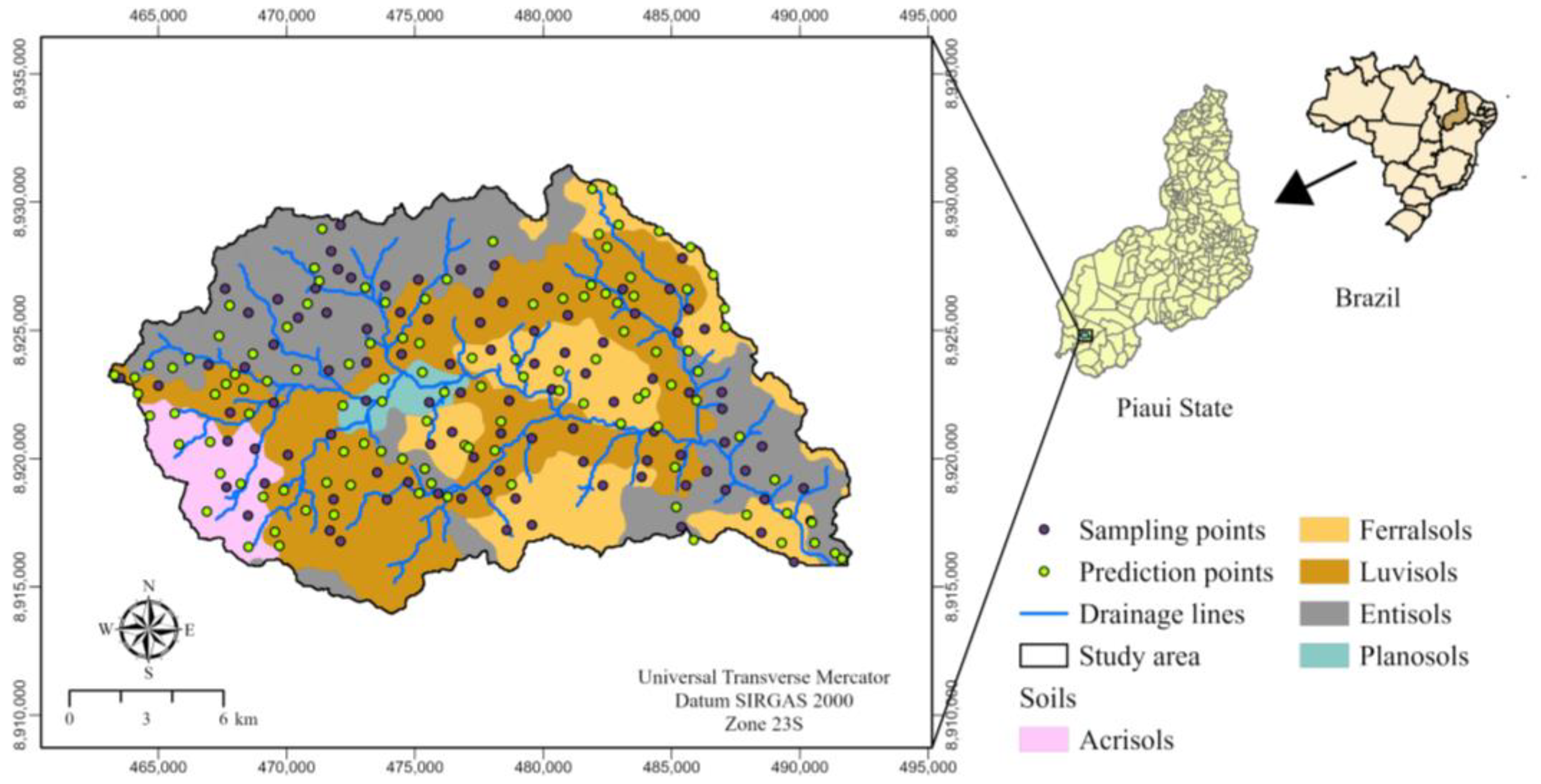
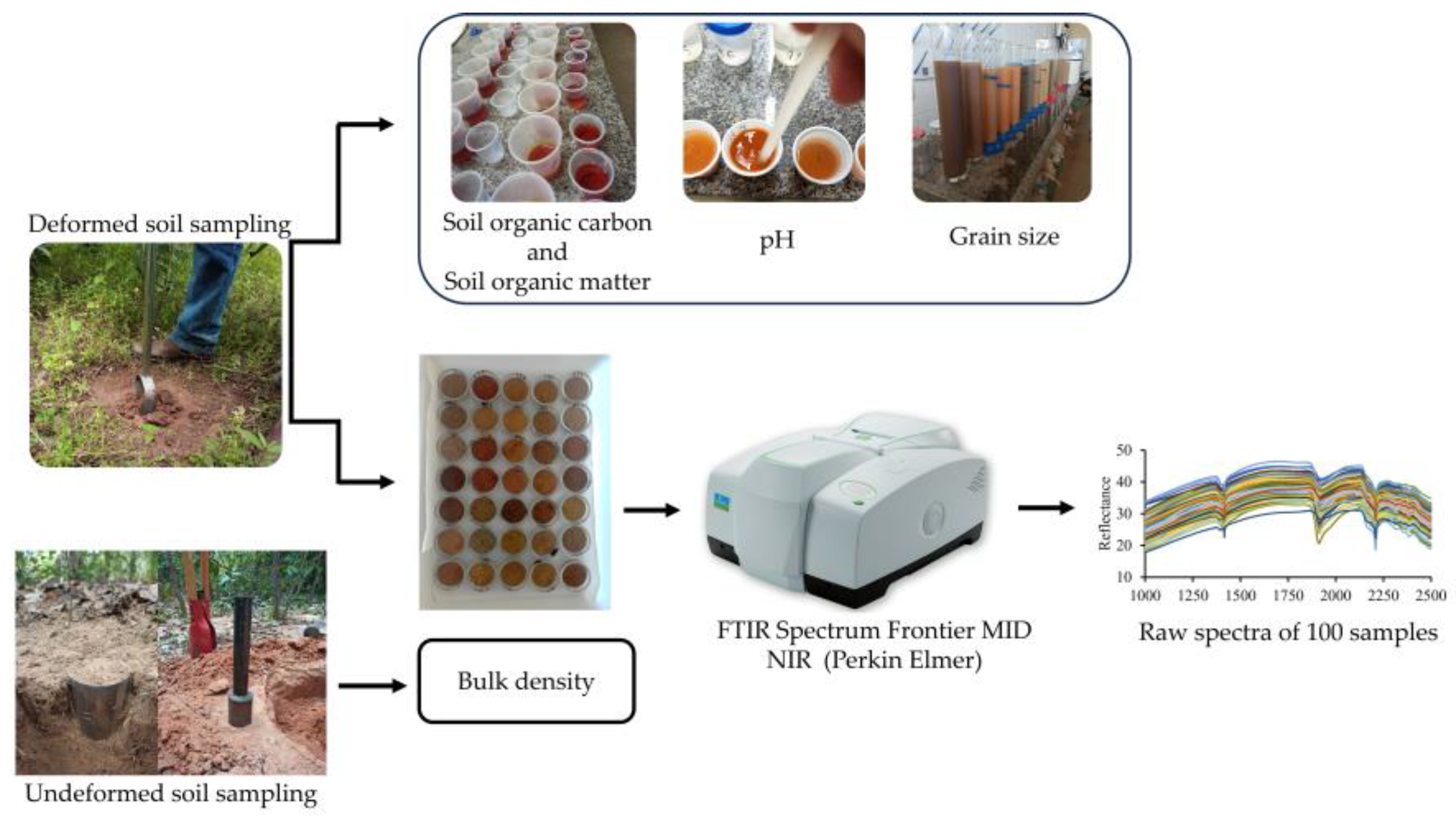
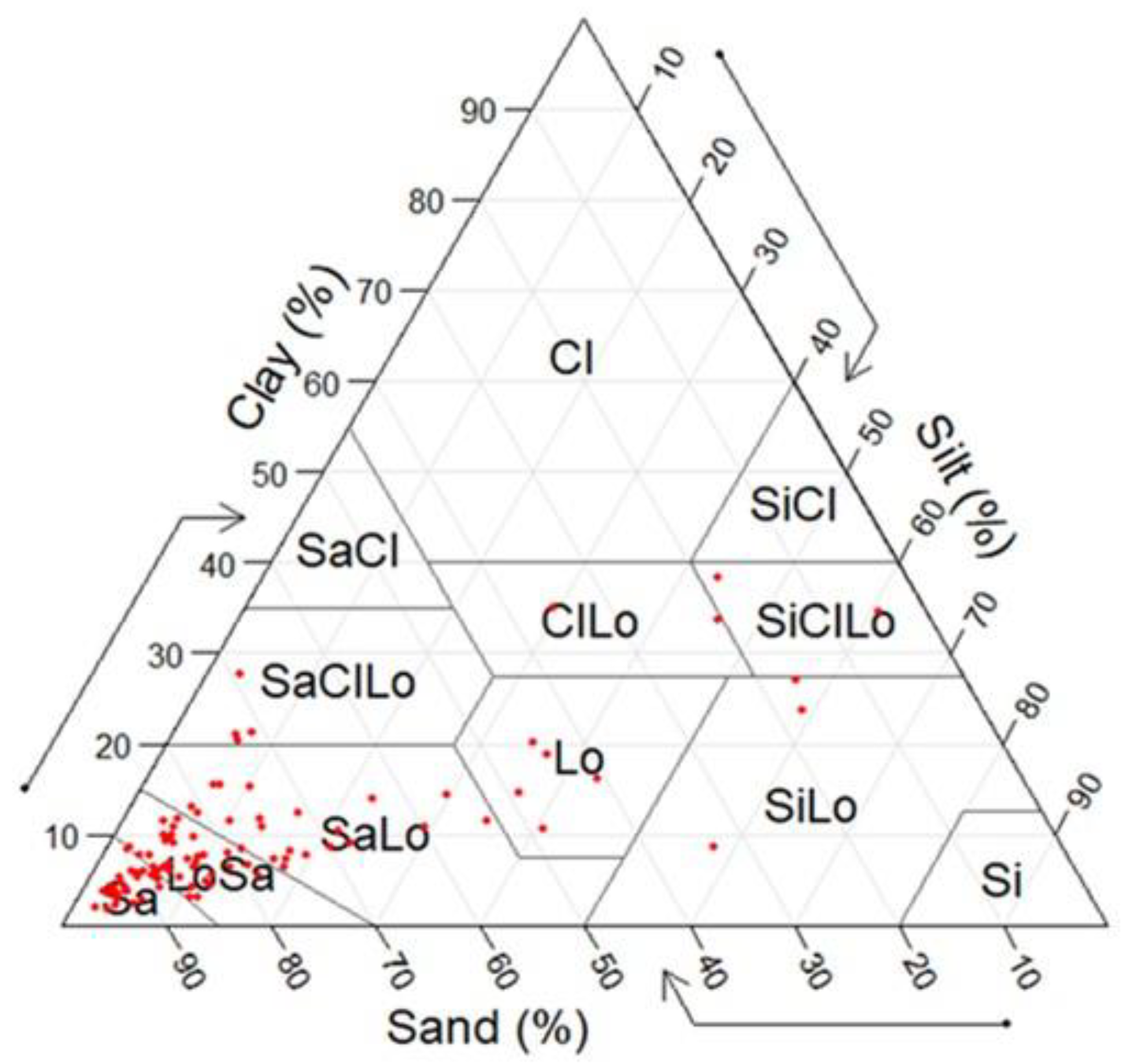
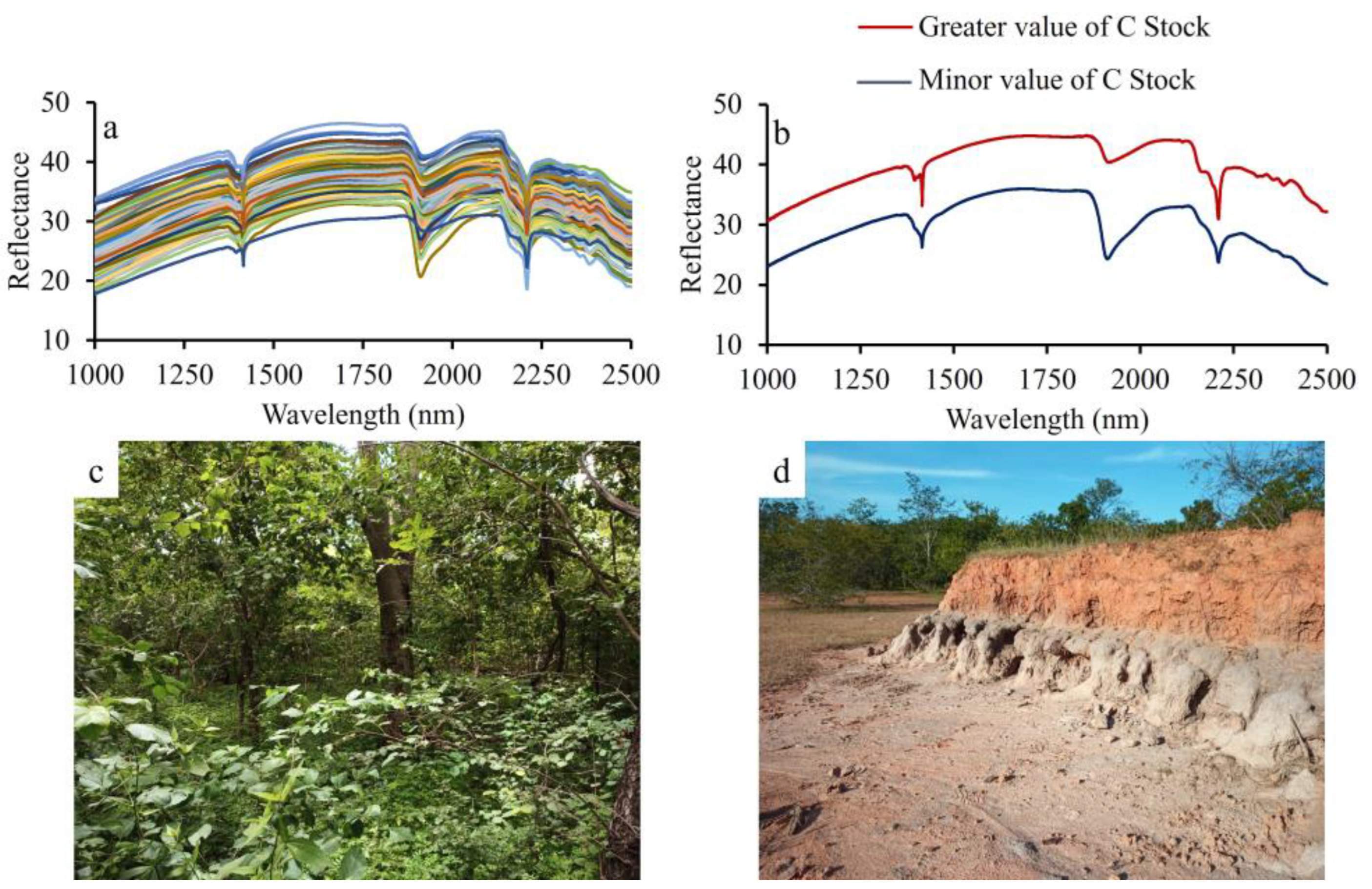
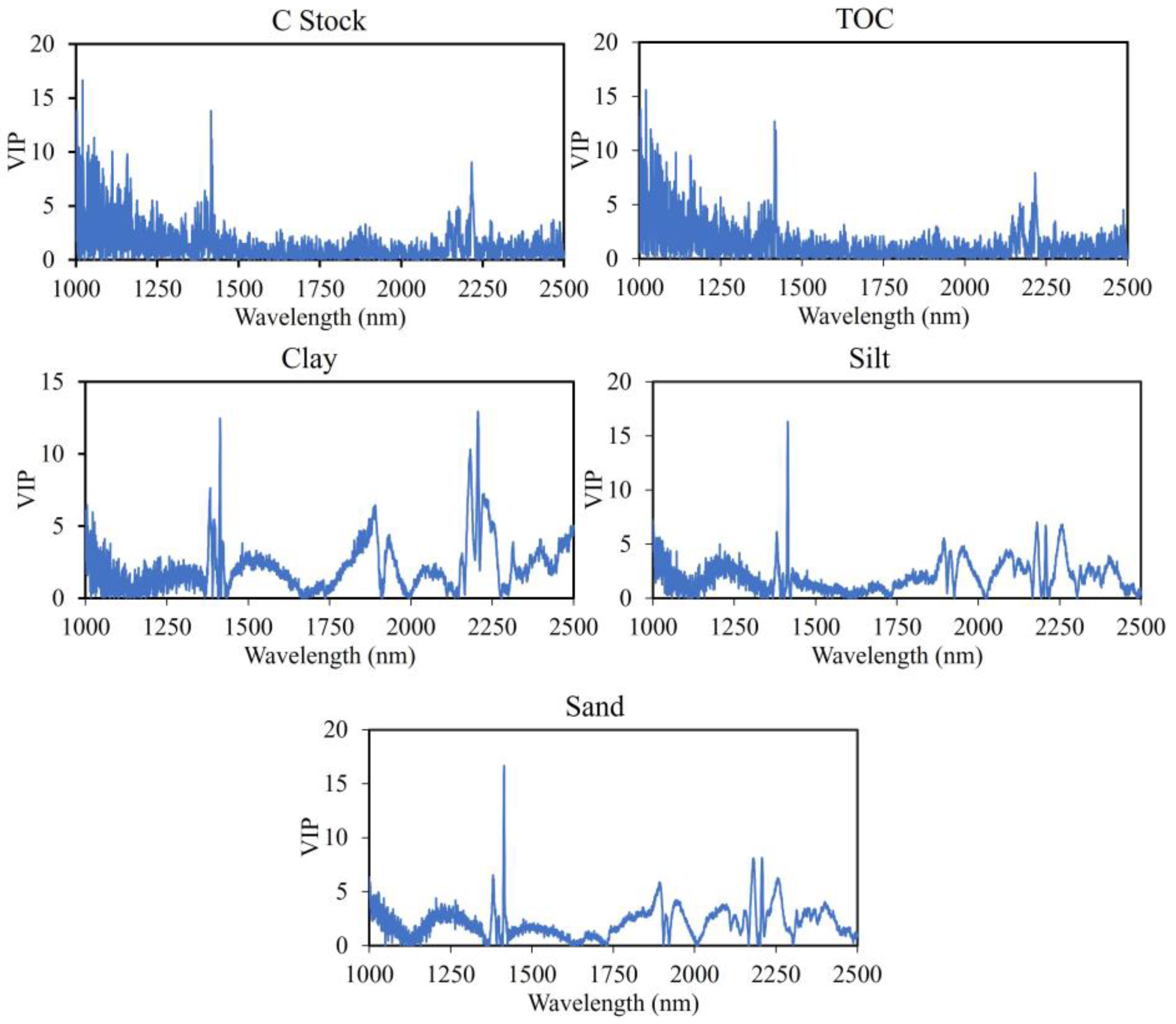

| Variable | n | Minimum | Average | Maximum | SD |
|---|---|---|---|---|---|
| Sand (g kg−1) | 100 | 46.90 | 768.20 | 958.20 | 195.80 |
| Silt (g kg−1) | 100 | 21.60 | 134.30 | 607.60 | 139.10 |
| Clay (g kg−1) | 100 | 17.93 | 97.59 | 381.85 | 74.98 |
| C Stock(Mg ha−1) | 100 | 5.76 | 71.42 | 234.73 | 43.12 |
| N Stock (Mg ha−1) | 100 | 0.08 | 0.93 | 2.63 | 0.56 |
| TOC (g kg−1) | 100 | 3.87 | 48.12 | 153.21 | 30.81 |
| TN (g kg−1) | 100 | 0.06 | 0.63 | 2.41 | 0.41 |
| BD (g/cm3) | 100 | 1.05 | 1.51 | 1.80 | 0.14 |
| pH (H2O) | 100 | 4.59 | 5.42 | 6.63 | 0.42 |
| Attributes | NF | Cross-Validation | External Validation | |||
|---|---|---|---|---|---|---|
| (n = 70) | (n = 30) | |||||
| R2adj | RMSE | RPD | R2adj | RMSE | ||
| Sand (g kg−1) | 8 | 0.77 | 78.06 | 2.11 | 0.62 | 186.37 |
| Silt (g kg−1) | 8 | 0.61 | 62.33 | 1.59 | 0.53 | 144.25 |
| Clay (g kg−1) | 8 | 0.75 | 29.26 | 1.84 | 0.67 | 43.13 |
| C Stock (Mg ha−1) | 5 | 0.62 | 11.08 | 1.75 | 0.53 | 67.99 |
| N Stock (Mg ha−1) | 2 | 0.04 | 0.48 | 1.03 | - | - |
| TOC (g kg−1) | 5 | 0.62 | 11.08 | 1.52 | 0.52 | 49.79 |
| TN (g kg−1) | 2 | 0.05 | 0.33 | 1.04 | - | - |
| BD (g cm3) | 4 | 0.07 | 0.14 | 0.92 | - | - |
| pH | 6 | 0.16 | 0.40 | 1.05 | - | - |
| Attributes | Data Set | Model | C0 | C0 + C | SDD (%) | Range (m) | R2 |
|---|---|---|---|---|---|---|---|
| Sand (g kg−1) | MG | Exponential | 710 | 19,440 | 3.65 | 1930 | 0.86 |
| PG | Exponential | 15,300 | 47,000 | 47.20 | 2000 | 0.82 | |
| Silt (g kg−1) | MG | Gaussian | 10 | 19,100 | 0.05 | 1400 | 0.95 |
| PG | Exponential | 7710 | 22,540 | 34.20 | 1960 | 0.85 | |
| Clay (g kg−1) | MG | Spherical | 700 | 5671 | 12.34 | 2800 | 0.93 |
| PG | Exponential | 2710 | 9350 | 28.98 | 2260 | 0.82 | |
| C Stock (Mg ha−1) | MG | Spherical | 1 | 1898 | 0.05 | 2160 | 0.95 |
| PG | Exponential | 57 | 948 | 6.01 | 1100 | 0.94 | |
| TOC (g kg−1) | MG | Spherical | 1 | 1000 | 0.1 | 2170 | 0.92 |
| PG | Exponential | 24 | 429 | 5.59 | 1110 | 0.94 |
| Attributes | R2 | RMSE |
|---|---|---|
| Sand (g kg−1) | 0.92 | 0.12 |
| Silt (g kg−1) | 0.90 | 0.13 |
| Clay (g kg−1) | 0.95 | 0.11 |
| C Stock (Mg ha−1) | 0.96 | 0.15 |
| TOC (g kg−1) | 0.97 | 0.15 |
Disclaimer/Publisher’s Note: The statements, opinions and data contained in all publications are solely those of the individual author(s) and contributor(s) and not of MDPI and/or the editor(s). MDPI and/or the editor(s) disclaim responsibility for any injury to people or property resulting from any ideas, methods, instructions or products referred to in the content. |
© 2023 by the authors. Licensee MDPI, Basel, Switzerland. This article is an open access article distributed under the terms and conditions of the Creative Commons Attribution (CC BY) license (https://creativecommons.org/licenses/by/4.0/).
Share and Cite
Sousa, J.C.G.d.; Silva, Y.J.A.B.d.; Martins, V.; Rodrigues, S.; Teixeira, M.P.R.; Dalto, P.H.; Neves, L.V.d.M.W.; Sánchez-Rodríguez, A.R.; Barbosa, R.S. Diffuse Reflectance Spectroscopy for Mapping Soil Carbon Stock in the Gilbués Desertification Region at Brazilian Cerrado. Land 2023, 12, 1812. https://doi.org/10.3390/land12091812
Sousa JCGd, Silva YJABd, Martins V, Rodrigues S, Teixeira MPR, Dalto PH, Neves LVdMW, Sánchez-Rodríguez AR, Barbosa RS. Diffuse Reflectance Spectroscopy for Mapping Soil Carbon Stock in the Gilbués Desertification Region at Brazilian Cerrado. Land. 2023; 12(9):1812. https://doi.org/10.3390/land12091812
Chicago/Turabian StyleSousa, Julio César Galdino de, Yuri Jacques Agra Bezerra da Silva, Vanessa Martins, Sueli Rodrigues, Marcos Paulo Rodrigues Teixeira, Paulo Henrique Dalto, Laércio Vieira de Melo Wanderley Neves, Antonio Rafael Sánchez-Rodríguez, and Ronny Sobreira Barbosa. 2023. "Diffuse Reflectance Spectroscopy for Mapping Soil Carbon Stock in the Gilbués Desertification Region at Brazilian Cerrado" Land 12, no. 9: 1812. https://doi.org/10.3390/land12091812
APA StyleSousa, J. C. G. d., Silva, Y. J. A. B. d., Martins, V., Rodrigues, S., Teixeira, M. P. R., Dalto, P. H., Neves, L. V. d. M. W., Sánchez-Rodríguez, A. R., & Barbosa, R. S. (2023). Diffuse Reflectance Spectroscopy for Mapping Soil Carbon Stock in the Gilbués Desertification Region at Brazilian Cerrado. Land, 12(9), 1812. https://doi.org/10.3390/land12091812






